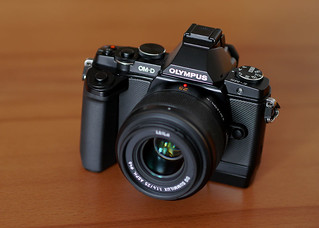Difference between revisions of "Olympus OM-D"
(removed broken photo unlikely to return) |
(images added) |
||
| Line 1: | Line 1: | ||
{{Flickr_image | {{Flickr_image | ||
|image_source= http://www.flickr.com/photos/smallrf/7506049722/in/pool-camerawiki | |image_source= http://www.flickr.com/photos/smallrf/7506049722/in/pool-camerawiki | ||
| − | |image= http://farm9.staticflickr.com/8293/ | + | |image= http://farm9.staticflickr.com/8293/7506049722_d3ae331a61_n.jpg |
|image_align= right | |image_align= right | ||
|image_text= <small>Olympus OM-D E-M5 with Summilux 1:1.4/25</small> | |image_text= <small>Olympus OM-D E-M5 with Summilux 1:1.4/25</small> | ||
| Line 7: | Line 7: | ||
|image_rights= (c) | |image_rights= (c) | ||
}} | }} | ||
| − | The '''Olympus OM-D''' [[system camera]] bodies resemble the [[35mm]] [[Olympus OM]] SLR series. Again the concept is to surpass the concept of the average concurrent system cameras. Both of the first OM-Ds, the Olympus OM-D | + | The '''Olympus OM-D''' [[system camera]] bodies resemble the [[35mm]] [[Olympus OM]] SLR series. Again the concept is to surpass the concept of the average concurrent system cameras. Both of the first OM-Ds, the Olympus OM-D E-M5 (2012) and the newer E-M1 reached that goal. Despite of their smaller µ4/3 image sensors both cameras delivered excellent respectable image quality in comparison with average [[APS-C]] sensor format cameras. Finally, in 2014 a budget version, the E-M10 was released. Backed by this success, [[Olympus]] gave up its [[Four Thirds]] DSLR series since the mirrorless OM-D took over the lead in Olympus camera portfolio. The old Four-Thirds system lenses can be used via adapter on OM-Ds. |
===Mark II=== | ===Mark II=== | ||
| − | In 2015 Olympus re-issued the OM-D E-M5, mightily reworked as ''Olympus OM-D E-M5 Mark II''. Its new specialty is a 5-axis sensor-shift anti-shake mechanism. This is also used for an 8-shot High-Res imaging mode with 2.5× sensor resolution as image resolution. | + | {{Flickr_image |
| + | |image_source= https://www.flickr.com/photos/russellmcneil/51149520696/in/pool-camerawiki | ||
| + | |image= https://live.staticflickr.com/65535/51149520696_18fd87c845_n_d.jpg | ||
| + | |image_align= left | ||
| + | |image_text= <small>Olympus OM-D E-M10 Mark II with adapted [[Four Thirds]] lens</small> | ||
| + | |image_by= Russell McNeil | ||
| + | |image_rights= nc | ||
| + | }}{{Flickr_image | ||
| + | |image_source= https://www.flickr.com/photos/zrodic/31711932941/in/pool-camerawiki | ||
| + | |image= https://live.staticflickr.com/743/31711932941_6d6fcff287_m.jpg | ||
| + | |image_align= center | ||
| + | |image_text= <small>Olympus OM-D E-M1 Mark II</small> | ||
| + | |image_by= Zoran Rodic | ||
| + | |image_rights= wp | ||
| + | }}{{Flickr_image | ||
| + | |image_source= https://www.flickr.com/photos/niels-enderlein/50374161548/in/pool-camerawiki | ||
| + | |image= https://live.staticflickr.com/65535/50374161548_f7ccf93a33_w_d.jpg | ||
| + | |image_align= right | ||
| + | |image_text= <small>Olympus OM-D E-M10 Mark III with kit lens</small> | ||
| + | |image_by= Zoran Rodic | ||
| + | |image_rights= wp | ||
| + | }}{{brl}} | ||
| + | In 2015 Olympus re-issued the OM-D E-M5, mightily reworked as ''Olympus OM-D E-M5 Mark II''. Its new specialty is a 5-axis sensor-shift anti-shake mechanism. This is also used for an 8-shot High-Res imaging mode with 2.5× sensor resolution as image resolution. It also got a bigger, more detailed viewfinder image. An OM-D E-M10 Mark II was also launched. In 2016, the Mark II variant of the of the E-M1 was released as first 20 [[megapixel]] OM-D, with a better sensor giving overall improved image quality. | ||
| + | ===Mark III=== | ||
| + | The Mark III variant of the OM-D E-M10 was introduced in 2017, the E-M5 Mark III, which was the first 20 megapixel E-M5, in 2019, the E-M1 Mark III in 2020. | ||
| + | ===Mark IV=== | ||
| + | The Mark IV variant of the OM-D E-M10 was introduced in 2020 by Olympus, finally having an E-M10 capable to shoot 20 megapixels, too. | ||
[[Category:Olympus|OM-D]] | [[Category:Olympus|OM-D]] | ||
[[Category:Micro four-thirds]] | [[Category:Micro four-thirds]] | ||
[[Category:Japanese digital system cameras]] | [[Category:Japanese digital system cameras]] | ||
[[Category:TIPA]] | [[Category:TIPA]] | ||
Revision as of 18:23, 7 May 2021

|
| Olympus OM-D E-M5 with Summilux 1:1.4/25 image by fotograf@flickr (Image rights) |
The Olympus OM-D system camera bodies resemble the 35mm Olympus OM SLR series. Again the concept is to surpass the concept of the average concurrent system cameras. Both of the first OM-Ds, the Olympus OM-D E-M5 (2012) and the newer E-M1 reached that goal. Despite of their smaller µ4/3 image sensors both cameras delivered excellent respectable image quality in comparison with average APS-C sensor format cameras. Finally, in 2014 a budget version, the E-M10 was released. Backed by this success, Olympus gave up its Four Thirds DSLR series since the mirrorless OM-D took over the lead in Olympus camera portfolio. The old Four-Thirds system lenses can be used via adapter on OM-Ds.
Mark II

|
| Olympus OM-D E-M10 Mark II with adapted Four Thirds lens image by Russell McNeil (Image rights) |

|
| Olympus OM-D E-M1 Mark II image by Zoran Rodic (Image rights) |

|
| Olympus OM-D E-M10 Mark III with kit lens image by Zoran Rodic (Image rights) |
In 2015 Olympus re-issued the OM-D E-M5, mightily reworked as Olympus OM-D E-M5 Mark II. Its new specialty is a 5-axis sensor-shift anti-shake mechanism. This is also used for an 8-shot High-Res imaging mode with 2.5× sensor resolution as image resolution. It also got a bigger, more detailed viewfinder image. An OM-D E-M10 Mark II was also launched. In 2016, the Mark II variant of the of the E-M1 was released as first 20 megapixel OM-D, with a better sensor giving overall improved image quality.
Mark III
The Mark III variant of the OM-D E-M10 was introduced in 2017, the E-M5 Mark III, which was the first 20 megapixel E-M5, in 2019, the E-M1 Mark III in 2020.
Mark IV
The Mark IV variant of the OM-D E-M10 was introduced in 2020 by Olympus, finally having an E-M10 capable to shoot 20 megapixels, too.